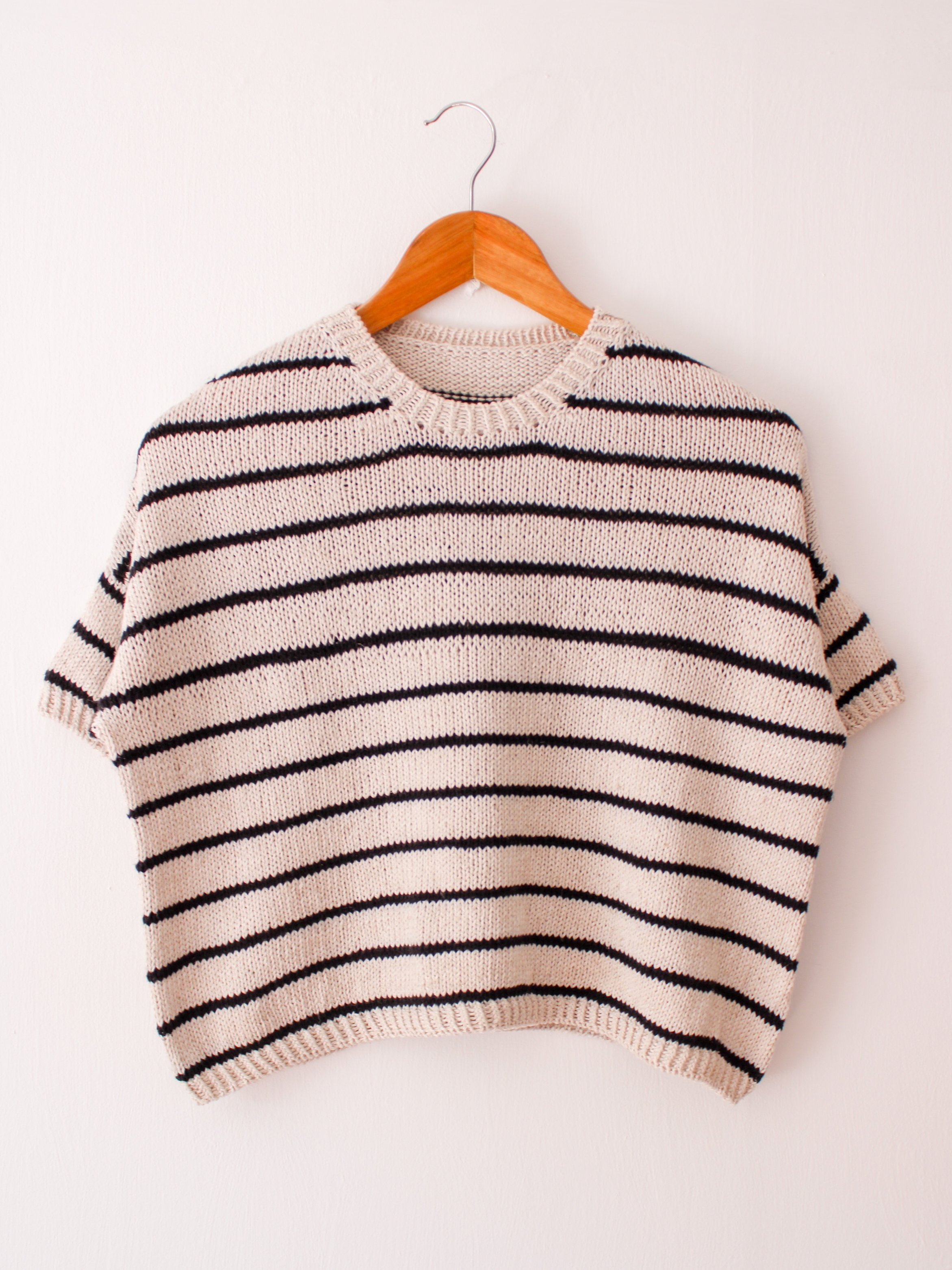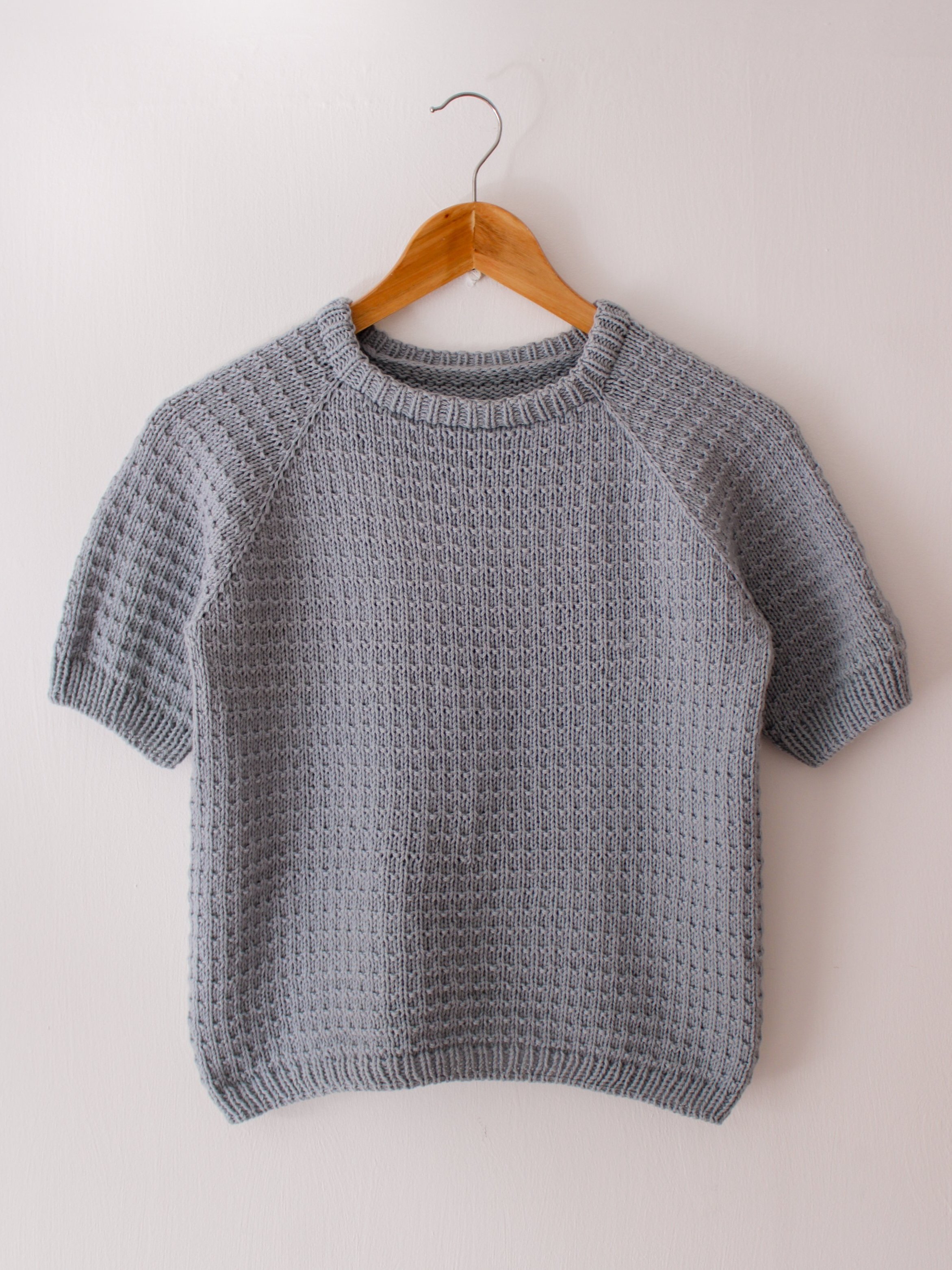Farnham Tee
The Farnham Tee is a slightly oversized drop-shoulder t-shirt, with stripes and a half-twisted rib collar, that is worked top down, both flat and in the round. The fit is very relaxed and slouchy, and the sleeves have a slight taper, finishing half-way down the upper arm.
The back panel is worked first with German short-row shaping to create sloping shoulders. Once the back panel is worked, the stitches are left to rest, and you will move on to work the front shoulders. The left shoulder is worked first with German short rows, and you then work the right shoulder, also with German short rows. You then join the two shoulders together and work the front panel to the same depth as the back panel. Next, you will join the front and back panels together to be worked in the round (with optional body shaping to create a tapered silhouette) until you are happy with the length. You then pick up and knit the stitches for each sleeve, working decreases to give the sleeves a little bit more shape. To finish, you pick up and knit the collar.
This pattern has been tech edited and test knitted. For pattern support, please get in touch via email.
Please note that this is a digital pdf and not a physical knitting pattern.
The Farnham Tee is a slightly oversized drop-shoulder t-shirt, with stripes and a half-twisted rib collar, that is worked top down, both flat and in the round. The fit is very relaxed and slouchy, and the sleeves have a slight taper, finishing half-way down the upper arm.
The back panel is worked first with German short-row shaping to create sloping shoulders. Once the back panel is worked, the stitches are left to rest, and you will move on to work the front shoulders. The left shoulder is worked first with German short rows, and you then work the right shoulder, also with German short rows. You then join the two shoulders together and work the front panel to the same depth as the back panel. Next, you will join the front and back panels together to be worked in the round (with optional body shaping to create a tapered silhouette) until you are happy with the length. You then pick up and knit the stitches for each sleeve, working decreases to give the sleeves a little bit more shape. To finish, you pick up and knit the collar.
This pattern has been tech edited and test knitted. For pattern support, please get in touch via email.
Please note that this is a digital pdf and not a physical knitting pattern.
The Farnham Tee is a slightly oversized drop-shoulder t-shirt, with stripes and a half-twisted rib collar, that is worked top down, both flat and in the round. The fit is very relaxed and slouchy, and the sleeves have a slight taper, finishing half-way down the upper arm.
The back panel is worked first with German short-row shaping to create sloping shoulders. Once the back panel is worked, the stitches are left to rest, and you will move on to work the front shoulders. The left shoulder is worked first with German short rows, and you then work the right shoulder, also with German short rows. You then join the two shoulders together and work the front panel to the same depth as the back panel. Next, you will join the front and back panels together to be worked in the round (with optional body shaping to create a tapered silhouette) until you are happy with the length. You then pick up and knit the stitches for each sleeve, working decreases to give the sleeves a little bit more shape. To finish, you pick up and knit the collar.
This pattern has been tech edited and test knitted. For pattern support, please get in touch via email.
Please note that this is a digital pdf and not a physical knitting pattern.
Materials & Fit
Notions: 3.5 mm / US 4 (80- and/or 100-cm / 32- and/or 40-in cords) and 4.5 mm / US 7 (60-, 80-, and 100-cm / 24-, 32-, and 40-in cords) circular needles. You may also find some 3.5 mm / US 4 and 4.5 mm / US 7 double-pointed knitting needles useful for the sleeves, but this is optional. You will also need a few stitch markers, a darning needle, and some spare needles/scrap yarn/stitch holders where the back panel will rest. At least 2 of the stitch markers should have a clip-on mechanism to help you keep track of your progress, especially when mapping out the short row shaping.
Yarn: If you want to work with 2 strands of fingering-weight yarn, I estimate that you will need approximately 460 (480) 540 (560) 620, (640) 700 (770) 870 (970) 1,080 m / 504 (525) 540 (591) 680, (700) 766 (843) 952 (1,061) 1,182 yds of Knitting for Olive Cotton Merino (70% organic cotton, 30% merino wool; 50 g = 250 m / 274 yds) held together with the same quantity of Knitting for Olive Pure Silk (100% silk; 50 g = 250 m / 274 yds in your main colour; and 105 (110) 120 (125) 140, (145) 160 (175) 200 (220) 250 m / 115 (121) 132 (137) 155, (160) 175 (192) 220 (241) 274 yds of the same two yarns held together with the same quantity of Pure Silk in your contrast colour. This works out to be 2 (2) 3 (3) 3, (3) 3 (4) 4 (4) 5 skeins of Cotton Merino and Pure Silk each in your main colour, and 1 (1) 1 (1) 1, (1) 1 (1) 1 (1) 1-2* skeins each of Cotton Merino and Pure Silk in your contrast colour.
If you would prefer to work with 1 strand of DK-weight yarn, I estimate that you will need approximately 500 (520) 570 (600) 660, (690) 750 (820) 940 (1,050) 1,160 m / 547 (570) 624 (667) 722, (755) 821 (1,028) 897 (1,150) 1,270 yds of Sandnes Garn Line (53% cotton, 33% viscose, 14% linen; 50 g = 110 m / 121 yds) in your main colour; and 105 (110) 120 (125) 140, (145) 160 (175) 200 (220) 250 m / 115 (121) 132 (137) 155, (160) 175 (192) 220 (241) 274 yds of the same two yarns held together in your contrast colour. This works out to be 5 (5) 6 (6) 6-7*, (7) 7 (8) 9 (10) 11 skeins of Line in your main colour, and 1 (1) 1-2* (2) 2, (2) 2 (2) 2 (2) 3 skeins of Line in your contrast colour.
Please note that these estimates are probably slightly generous and are based on test knitters' feedback and my sample garments. If you are using Sandnes Garn Line (or a similar alternative), I found both with my own sample garment and in the testers' feedback that slightly more yarn is needed (possibly because of the lack of elasticity). If you alter the length significantly, you may need more yarn.
If there is an asterisk next to the quantity of skeins you will need for your size, it means that I think you will just need to dip into an extra skein. You may wish to purchase the smaller amount of yarn given for your size, but this may results in a game of yarn chicken so I strongly recommend purchasing the extra yarn where possible.
For the first sample garment (Size D), I used 3 skeins of Knitting for Olive Cotton Merino in the shade Natural White (main colour) and 1 skein of Knitting for Olive Cotton Merino in the shade Rust (contrast colour) held together with 3 skeins of Knitting for Olive Pure Silk in the shade Cream (main colour) and 1 skein of Knitting for Olive Pure Silk in the shade Copper (contrast colour).
For the second sample garment (Size D), I used 7 skeins of Sandnes Garn Line in the shade Kitt 1015 (main colour) and 2 skeins of Sandnes Garn Line in the shade Black 1099 (contrast colour).
Yarn alternatives: Any DK-weight yarn or combination of fingering-weight yarns held double will work nicely for this project, and I would recommend yarns will good drape where possible. If you don't like the feel of cotton or silk, you could use a 100% merino fingering-weight yarn, like Knitting for Olive Merino (100% merino wool; 50 g = 250 m / 273 yds or Sandnes Garn Sunday (100% merino wool; 50 g = 235 m / 257 yds) instead of the Knitting for Olive Cotton Merino or Pure Silk; or you could just hold 2 strands of Cotton Merino or Pure Silk, depending on your preferences. If you are looking for an alternative to Pure Silk, Rosários4 Madragoa (100% silk; 50 g = 200 m / 219 yds is a good option. If you're looking to hold a single strand of yarn, BC Garn Big Bio Balance (55% wool, 45% cotton; 100 g = 280 m / 306 yds) is a great option. Finally, you could use Drops Belle (53% cotton, 33% viscose, 14% linen; 50 g = 110 m / 121 yds) held single.
Tension: 20 sts x 28 rows and rounds in Stockinette stitch on 4.5 mm / US 7 needles. Make sure to wash and block your swatch for the most accurate results.
Sizing and ease: The Farnham Tee has a recommended positive ease of 15-20 cm / 6-8 in around the chest (or the widest part of your torso) for Sizes A-H, and 15-25 cm / 6-10 in for Sizes I-K. If you want a tighter fit, you should feel free to size down, and vice versa.
Size: A (B) C (D) E, (F) G (H) I (J) K
Chest measurement (cm): 75-80 (80-85) 85-90 (90-95) 95-100, (100-105) 105- 110 (110-115) 115-125 (125-135) 135-145
Chest measurement (in): 29.5-31.5 (31.5-33.5) 33.5-35.5 (35.5-37.5) 37.5-39.25, (39.25-41.25) 41.25-43.25 (43.25-45.25) 45.25-49.25 (49.25-53.25) 53.25-57
Actual circumference of garment (cm): 95 (100) 105 (110) 115, (120) 125 (130) 140 (150) 160
Actual circumference of garment (in): 37.5 (39.25) 41.25 (43.25) 45.25, (47.25) 49.25 (51.25) 55 (59) 63
Actual armhole depth (cm): 15 (15.5) 16 (16.5) 17, (18) 18.5 (19) 21 (23) 25
Actual armhole depth (in): 6 (6) 6.25 (6.5) 6.75, (7) 7.25 (7.5) 8.25 (9) 9.75
Sleeve circumference at upper bicep (cm): 30 (31) 32 (33) 35, (36) 37 (38) 42 (46) 50
Sleeve circumference at upper bicep (in): 11.75 (12.25) 12.5 (13) 13.75, (14.25) 14.5 (15) 16.5 (18) 19.75
Recommended sleeve length (cm): 10.5, with options to modify if so desired
Recommended sleeve length (in): 4, with options to modify if so desired
Recommended length from bottom of collar to hem (cm): 46 (46) 49.25 (49.25) 52.5, (52.5) 55.75 (59) 62.5 (65.5) 68.5
Recommended length from bottom of collar to hem (in): 18 (18) 19.5 (19.5) 20.75, (20.75) 22 (23.25) 24.5 (25.75) 27
Techniques include German short rows, leaning increases and (optional) decreases, picking up stitches along a vertical and a horizontal edge, and a tubular cast-off. This is an intermediate-level pattern that is not suitable for less confident knitters.


























